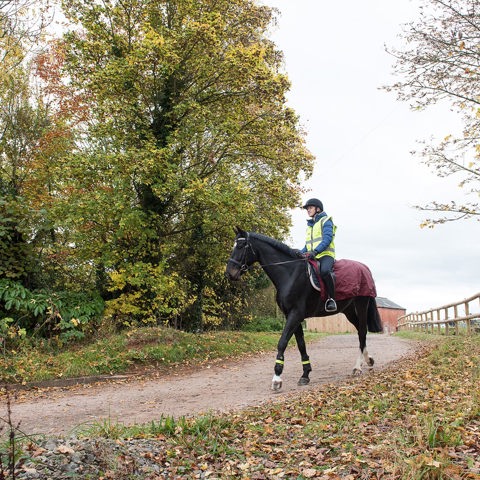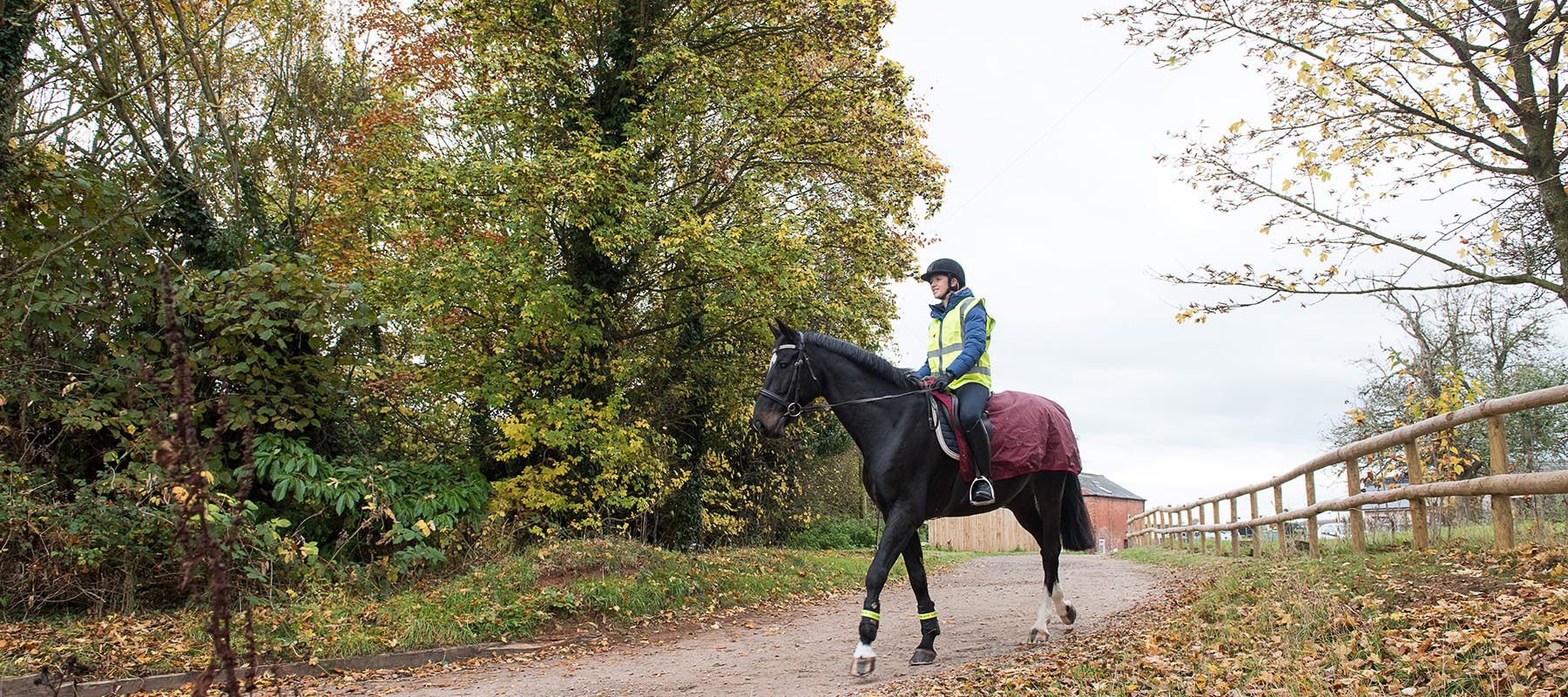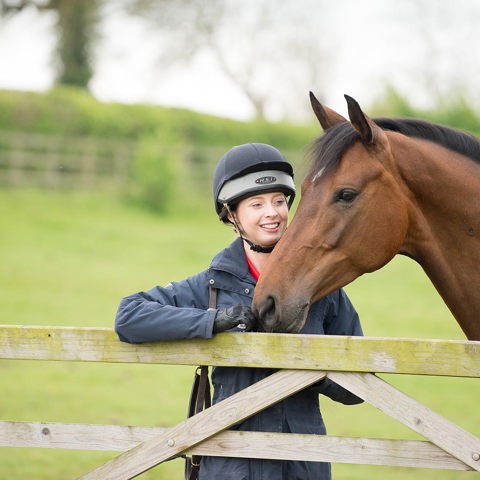The three phases of fitness
All horses are individuals with different requirements and the information below provides a general timeline and guidance only. If you’ve any concerns about progressing your horse to the next fitness phase, keep them at their current workload until you’re satisfied they’re coping. If your horse has been off work due to an injury, follow advice from your vet for their rehabilitation.
Phase One: Slow & Steady (Weeks one-three)
chevron-down
chevron-up
Objectives:
- Gradual controlled exercise to strengthen the soft tissue
- Prepare the muscles, tendons and ligaments for harder work
Workload:
Week one: Walk work for 20 minutes, moving in straight lines on a level surface.
Week two: Increase to 30-40 minutes, reaching an hour.
Week three: Continue walk work up to one hour, including hill work and large shapes:
-
- Work on varied surfaces such as arenas, roads and grass. Each surface gives slightly different benefits to the development of the horse’s soft tissue1.
- Avoid sudden changes of surface (for example, normal to hard, normal to soft or hard to soft ground) as this can increase the risk of injury to the horse. Surface transitions are best done at a walk or a trot if the horse is well-balanced and on a straight line.
Phase Two: Strength & Stamina (Weeks four-five)
chevron-down
chevron-up
Objectives:
- Improve basic fitness and strength
- Suppling and developing muscle
- Develop balance and self-carriage
Workload:
Week four: Continue hacking out and introduce short schooling sessions (20-30 minutes). Include up to five minutes of trot work per session, where the horse trots continuously for one to two minutes at a time.
Week five: Introduce pole work, basic lateral work and lungeing or long reining. Always make sure to keep circles big and lunge for no more than 20 minutes.
Phase Three: Schooling & Speed (Weeks six-nine)
chevron-down
chevron-up
Objectives:
- Develop the efficiency of the heart and lungs
- Longer training sessions
- Interval training.
Workload:
Weeks six-eight: Introduce canter work, longer schooling sessions and jump training into sessions. Include interval training, which is short periods of intense exercise, for example, trotting for two minutes or cantering for one minute followed by a recovery period. As fitness improves, the period of exercise can increase and recovery period decrease.
Week nine onwards: your horse should now be back to an adequate level of fitness.
Keep Assessing
Continually assess your horse’s recovery times, and how they’re coping with their work. As their fitness develops you should notice that their heart rate and breathing rate are lower during exercise and that both rates recover more quickly when you stop exercising. If this is not the case, you may need to extend certain weeks. Slow work now will lay down the foundations for faster work later and will minimise the risk of injury.
Monitor your horse’s behaviour
chevron-down
chevron-up
It’s important to know when your horse’s behaviour is giving an indication of pain, stress or a sign that that they’re not coping in some way. This can be shown by any subtle changes to their behaviour.
Be aware of ground conditions
chevron-down
chevron-up
The condition of the ground that you’re riding on will impact your horse’s physical wellbeing. It’s important to take this into consideration before starting each training session to minimise the risk of your horse getting injured. Things to look out for include:
- Is the arena level? Make sure that your arena surface is levelled regularly to avoid the horse tripping or causing uneven strain on their muscles and tendons.
- Has it been raining excessively making the ground slippery or slightly deep? If the ground is deep or slippery, you may need to add studs to your horse’s shoes or change the location for your session.
- Is the ground hard? If the ground conditions are excessively hard you may need to find a softer surface to ride on, alternatively you can work at a slower pace (mostly walk) to avoid excessive concussion.
Road work
Traditionally, people believed that lots of trotting on roads was essential for getting horses fit and to strengthen the horse’s tendons. Science has now shown that there is no evidence for this and instead this could be causing harm to the horse.
When horses trot on roads for long periods, the impact forces (like shockwaves) are much higher than on good grass (not hard ground) or an arena surface3. This can cause or worsen arthritis in the horse’s joints, particularly in the feet, fetlock and knees4.
Whether your horse is shod or unshod, the increased forces still have the same effect inside of the hoof. Once the forces reach the fetlock and knee, the potential for damage is the same in both5.
Trotting on roads does strengthen bones, but no more than five minutes per session broken into one-to-two-minute intervals is needed for this improvement6.
Warming Up and Cooling Down
Warming up and cooling down properly is essential to help keep your horse’s muscle tone elastic and to reduce the risk of injuries to tendons and ligaments. It can also help to prevent painful muscle cramps and colic8.
Warming up
chevron-down
chevron-up
Warming up gets your horse thinking about the job they’re about to do. It raises their heart rate, boosts circulation and increases oxygen flow to the muscles. An effective warm up will help to prevent discomfort and reduces the risk of injury, as well as improving overall performance.
Your warm-up plan can be split into two phases:
- General movement: Start with easy walking and trotting, similar to a gentle warm-up jog for humans. This is to raise the horse’s heart rate.
- Dynamic movement: Introduce some circles, turns, transitions, lateral movements and pole work. This will get the horse’s muscles and joints more relaxed and moving smoothly.
Once your horse feels sufficiently warmed-up, you can move into the working phase and practise specific skills such as dressage movements or jumping, to work on fine-tuning your horse’s abilities.
Top tips:
- Short breaks: Take short breaks between training sessions or before moving to a more challenging effort
- Long recovery: If your horse has a long rest period, start with a fresh warm-up before returning to more challenging efforts
There are no rigid rules but take into consideration the weather, ground conditions, temperament of your horse and how they’re feeling on the day. Horses being ridden from the stable will need a longer time to warm-up than those ridden from the field.
Cooling Down
chevron-down
chevron-up
Just like humans, horses need a cool down phase after every training session. There are several things to consider during your cool down:
- Physical and mental recovery: Cooling down reduces the heart rate, drawing lactic acid away from the muscles and reducing the risk of inflammation. Cooling also allows the horse a chance to process the work they’ve done and return to a less focused state of mind.
- Slower work: Gradually bring the horse back down the paces, then walk until their respiration rate has recovered.
- Encourage your horse to stretch: Your horse should relax and lengthen their body and help release any tension.
- Monitor tiredness: Monitor your horse’s energy levels. If they seem tired or their movement quality declines, it’s time to stop.
- Temperature check: Consider the air temperature. If it’s cold, put on an exercise sheet to stop them cooling too quickly and help prevent muscle tightness and cramping.
- Muscle soreness: Unfortunately, there’s no way of completely avoiding muscle soreness, especially after a challenging training session. But a thorough cool down will reduce the risk of your horse experiencing discomfort.
Aftercare
Following every ride:
- Wash or brush off any sweat marks. Check for saddle rubs, girth galls and bit rubs.
- Check legs for heat and swelling. Icing/cold hosing the horse’s legs after intense exercise, such as cross country or endurance riding, reduces inflammation in soft tissues (e.g. tendons and ligaments) and prevents them getting weaker. This will also reduce the risk of injury to the horse7.
- Pick out feet and if wearing shoes, check they’re still secure.
- During warmer weather, watch out for signs of heat-related illness.
- Keep walking your horse if they’re still breathing heavily, and never put a hot, blowing horse back in their stable unattended, as they’re at high risk of overheating, developing muscle cramps or colic.
Seek guidance from a BHS Accredited Professional Coach (APC) at any stage if you are uncertain or would like advice.
References
1) Skivington A, et al. (2020). Investigation into Whether Proximal Suspensory Desmitis of the Hindlimb Could Predispose Horses to Sacroiliac Disease. Equine Science.
2) Parkes R.S.V & Witte T.H (2015) The foot–surface interaction and its impact on musculoskeletal adaptation and injury risk in the horse. Equine Veterinary Journal.47(5) P. 519-525.
3) Chateau, H. et al 2010. Biomechanical analysis of hoof landing and stride parameters in harness trotter horses running on different tracks of a sand beach (from wet to dry) and on an asphalt road. Equine Veterinary Journal, 42, pp.488-495.
4) Barstow, A. et al. 2019. Does ‘hacking’surface type affect equine forelimb foot placement, movement symmetry or hoof impact deceleration during ridden walk and trot exercise?. Equine veterinary journal, 51(1), pp.108-114.
5) Panagiotopoulou, O. et al 2016. A preliminary case study of the effect of shoe-wearing on the biomechanics of a horse’s foot. PeerJ, 4, p.e2164.
6) Roadwork - Some things to consider! - AskAnimalweb (drdavidmarlin.com)
7) Marlin, D.J., (2019). Evaluation of the cooling efficacy of different equine leg cooling methods in: Comparative Exercise Physiology Volume 15 Issue 2 (2019) (brill.com)
8) The British Horse Society & University of Nottingham. 2018. Reducing the Risk of Colic



